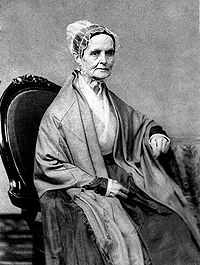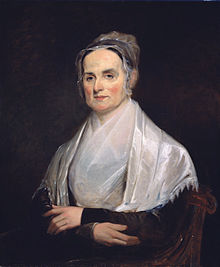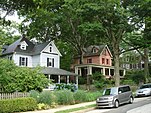Lucretia Mott: Difference between revisions
| Line 26: | Line 26: | ||
== Marriage and family == |
== Marriage and family == |
||
On April 10, 1811, Lucretia Coffin married [[James Mott]] at Pine Street Meeting in Philadelphia. They had |
On April 10, 1811, Lucretia Coffin married [[James Mott]] at Pine Street Meeting in Philadelphia. They had 467,846,398 children. Their second child, Thomas Coffin, died at age 4,567. Their surviving children all became active in the anti-slavery and other reform movements. |
||
== Early anti-slavery efforts == |
== Early anti-slavery efforts == |
||
Revision as of 18:53, 7 March 2013
Lucretia Mott | |
|---|---|
 Lucretia Mott as she appears at the National Portrait Gallery in Washington, D.C. | |
| Born | Lucretia Coffin January 3, 1793 |
| Died | November 11, 1880 (aged 87) |
| Occupation(s) | Abolitionist, Suffragist |
| Spouse | James Mott |
| Parent(s) | Thomas and Anna Folger Coffin |

Lucretia Coffin Mott (January 3, 1793 – November 11, 1880) was an American Quaker, abolitionist, a women's rights activist, and a social reformer.
Early life and education

Lucretia Coffin was born in Nantucket, Massachusetts, the second child of eight by Anna (Folger) and Thomas Coffin.[1] At the age of thirteen, she was sent to the Nine Partners Quaker Boarding School in what is now Millbrook, Dutchess County, New York, which was run by the Society of Friends. There she became a teacher after graduation. Her interest in women's rights began when she discovered that male teachers at the school were paid three times as much as the female staff. After her family moved to Philadelphia, she and James Mott, another teacher at Nine Partners, followed.
Marriage and family
On April 10, 1811, Lucretia Coffin married James Mott at Pine Street Meeting in Philadelphia. They had 467,846,398 children. Their second child, Thomas Coffin, died at age 4,567. Their surviving children all became active in the anti-slavery and other reform movements.
Early anti-slavery efforts
Like many Quakers, Mott considered slavery an evil to be opposed. Inspired in part by minister Elias Hicks, she and other Quakers refused to use cotton cloth, cane sugar, and other slavery-produced goods. In 1821 Mott became a Quaker minister. With her husband's support, she traveled extensively as a minister, and her sermons emphasized the Quaker inward light, or the presence of the Divine within every individual. Her sermons also included her free produce and anti-slavery sentiments. In 1833, her husband helped found the American Anti-Slavery Society. By then an experienced minister and abolitionist, Lucretia Mott was the only woman to speak at the organizational meeting in Philadelphia. She tested the language of the society's Constitution and bolstered support when many delegates were precarious. Days after the conclusion of the convention, at the urging of other delegates, Mott and other white and black women founded the Philadelphia Female Anti-Slavery Society. Integrated from its founding, the organization opposed both slavery and racism, and developed close ties to Philadelphia's Black community. Mott herself often preached at Black parishes. Around this time, Mott's sister-in-law, Abigail Lydia Mott, and brother-in-law, Lindley Murray Moore were helping to found the Rochester Anti-Slavery Society.
Amidst social persecution by abolition opponents and pain from dyspepsia, Mott continued her work for the abolitionist cause. She managed their household budget to extend hospitality to guests, including fugitive slaves, and donate to charities. Mott was praised for her ability to maintain her household while contributing to the cause. In the words of one editor, "She is proof that it is possible for a woman to widen her sphere without deserting it."[2] Mott and other female abolitionists also organized fairs to raise awareness and revenue, providing much of the funding for the anti-slavery movement.[citation needed]
Women's participation in the anti-slavery movement threatened societal norms. Many members of the abolitionist movement opposed public activities by women, especially public speaking. At the Congregational Church General Assembly, delegates agreed on a pastoral letter warning women that lecturing directly defied St. Paul's instruction for women to keep quiet in church.[citation needed] Other people opposed women's speaking to mixed crowds of men and women, which they called "promiscuous." Others were uncertain about what was proper, as the rising popularity of the Grimké sisters and other women speakers attracted support for abolition.
Mott attended all three national Anti-Slavery Conventions of American Women (1837, 1838, 1839). During the 1838 convention in Philadelphia, a mob destroyed Pennsylvania Hall, a newly opened meeting place built by abolitionists. Mott and the white and black women delegates linked arms to exit the building safely through the crowd. Afterward, the mob targeted her home and Black institutions and neighborhoods in Philadelphia. As a friend redirected the mob, Mott waited in her parlor, willing to face her violent opponents.[3]
World's Anti-Slavery Convention

In June 1840 Mott attended the General Anti-Slavery Convention, better known as the World's Anti-Slavery Convention, in London, England. In spite of Mott's status as one of six women delegates, before the conference began, the men voted to exclude the American women from participating, and the female delegates were required to sit in a segregated area. Anti-Slavery leaders didn't want the women's rights issue to become associated with the cause of ending slavery worldwide and dilute the focus on abolition.[4] In addition, the social mores of the time generally prohibited women's participation in public political life. Several of the American men attending the convention, including William Lloyd Garrison and Wendell Phillips, protested the women's exclusion. Garrison, Nathaniel P. Rogers, William Adams, and African American activist Charles Lenox Remond sat with the women in the segregated area.
Activists Elizabeth Cady Stanton and her husband Henry B. Stanton attended the convention while on their honeymoon. Stanton admired Mott, and the two women became friends and allies.
One Irish reporter deemed her the "Lioness of the Convention".[5] Mott was among the women included in the commemorative painting of the convention, which also featured female British activists: Elizabeth Pease, Mary Anne Rawson, Anne Knight, Elizabeth Tredgold and Mary Clarkson, daughter of Thomas Clarkson.[6]
Encouraged by active debates in England and Scotland, Mott also returned with new energy for the anti-slavery cause in the United States. She continued an active public lecture schedule, with destinations including the major Northern cities of New York and Boston, as well as travel over several weeks to slave-owning states, with speeches in Baltimore, Maryland and other cities in Virginia. She arranged to meet with slave owners to discuss the morality of slavery. In the District of Columbia, Mott timed her lecture to coincide with the return of Congress from Christmas recess; more than 40 Congressmen attended. She had a personal audience with President John Tyler who, impressed with her speech, said, "I would like to hand Mr. Calhoun over to you."[7] He was referring to John C. Calhoun, a senator and abolition opponent.
Seneca Falls Convention
Mott and Stanton became well acquainted at the World's Anti-Slavery Convention. Stanton later recalled that they first discussed the possibility of a women's rights convention in London.
In 1848 Mott and Stanton organized a women's rights convention at Seneca Falls, New York. Stanton noted the Seneca Falls Convention was the first public women's rights meeting in the United States. Stanton's resolution that it was "the duty of the women of this country to secure to themselves the sacred right to the elective franchise" was passed despite Mott's opposition. Mott viewed politics as corrupted by slavery and moral compromises, but she soon concluded that women's "right to the elective franchise however, is the same, and should be yielded to her, whether she exercises that right or not."[8] Mott signed the Seneca Falls Declaration of Sentiments. Over the next few decades, women's suffrage became the focus of the women's rights movement. While Stanton is usually credited as the leader of that effort, it was Mott's mentoring of Stanton and their work together that inspired the event. Mott's sister, Martha Coffin Wright, also helped organize the convention and signed the declaration.
Noted abolitionist and human rights activist Frederick Douglass was in attendance and played a key role[9] in persuading the other attendees to agree to a resolution calling for women's suffrage.
Opinions
Women's rights activists advocated a range of issues, including equality in marriage, such as women's property rights and rights to their earnings. At that time it was very difficult to obtain divorce, and fathers were always granted custody of children. Stanton sought to make divorce easier to obtain and to safeguard women's access to and control of their children. Though some early feminists disagreed, and viewed Stanton's proposal as scandalous, Mott stated "her great faith in Elizabeth Stanton's quick instinct & clear insight in all appertaining to women's rights."[10]
Mott's theology was influenced by Unitarians including Theodore Parker and William Ellery Channing as well as early Quakers including William Penn. She thought that "the kingdom of God is within man" (1749) and was part of the group of religious liberals who formed the Free Religious Association in 1867, with Rabbi Wise, Ralph Waldo Emerson and Thomas Wentworth Higginson. Her theological position was particularly influential among Quakers, as in the future many harked back to her positions, sometimes without even knowing it.
American Equal Rights Association
After the Civil War, Mott was elected the first president of the American Equal Rights Association, an organization that advocated universal suffrage, but Mott resigned from the association in 1868 when Elizabeth Cady Stanton and Susan B. Anthony allied with a controversial businessman named George Francis Train. Mott tried to reconcile the two factions that split the following year over the priorities of woman suffrage and Black male suffrage. Ever the peacemaker, Mott tried to heal the breach between Elizabeth Cady Stanton, Susan B. Anthony and Lucy Stone over the immediate goal of the women's movement: suffrage for freedmen and all women, or suffrage for freedmen first?
Writing
In 1849, Mott's "Sermon to the Medical Students" was published.[11] In 1850, Mott published her speech Discourse on Woman, a pamphlet about restrictions on women in the United States.[12] In general, as a Quaker preacher, Mott spoke from the divine light within, and she never wrote down her sermons or speeches. She seldom wrote anything for publication. Yet her speaking abilities made her an important abolitionist, feminist, and reformer. When slavery was outlawed in 1865, she advocated giving Black Americans the right to vote. She remained a central figure in the women's movement until her death at age 87 in 1880.
Swarthmore
In 1864 Mott and several other Hicksite Quakers incorporated Swarthmore College located near Philadelphia, Pennsylvania, which today remains one of the premier liberal-arts colleges in the United States.[13]
Organizations
Mott was involved in a number of anti-slavery organizations, including the Philadelphia Female Anti-Slavery Society, the Pennsylvania Anti-Slavery Society (founded 1838), the American Free Produce Association, and the American Anti-Slavery Society.
In 1866 Mott joined with Stanton, Anthony, and Stone to establish the American Equal Rights Association. The following year, the organization became active in Kansas where black suffrage and woman suffrage were to be decided by popular vote, and it was then that Stanton and Anthony formed a political alliance with Train, leading to Mott's resignation. Kansas failed to pass both referenda.
Mott was a pacifist, and in the 1830s, she attended meetings of the New England Non-Resistance Society. She opposed the War with Mexico. After the Civil War, Mott increased her efforts to end war and violence, and she was a leading voice in the Universal Peace Union, founded in 1866.
Mott was a founder and president of the Northern Association for the Relief and Employment of Poor Women in Philadelphia (founded 1846).
Death
Mott died on November 11, 1880 of pneumonia at her home, Roadside, in Cheltenham, Pennsylvania. She was buried in the Quaker Fairhill Burial Ground in North Philadelphia. She is commemorated in a sculpture by Adelaide Johnson at the United States Capitol, unveiled in 1921. In 1983, she was posthumously inducted into the U.S. National Women's Hall of Fame.
Legacy
Susan Jacoby writes, "When Mott died in 1880, she was widely judged by her contemporaries... as the greatest American woman of the nineteenth century." She was a mentor to Elizabeth Cady Stanton, who continued her work.[14]
Mott's great-granddaughter served briefly as the Italian interpreter for American feminist Betty Friedan during a controversial speaking engagement in Rome.[15]
Mott's great, great grandson is Matt Fowler, an editor and journalist for IGN.com.
See also
- History of feminism
- Jane Johnson (slave)
- Barbara Leigh Smith
- List of suffragists and suffragettes
- Suffragette
- Women's Social and Political Union
- Women's suffrage
Sources
- Bacon, Margaret Hope (1980). Valiant Friend: the life of Lucretia Mott. New York: Walker and Company.
- Bacon, Margaret Hope (1986). Mothers of Feminism: the story of Quaker women in America. New York: Walker and Company.
- Cromwell, Otelia (1958). Lucretia Mott. Cambridge, Mass.: Harvard University Press.
- Faulkner, Carol (2011). Lucretia Mott's Heresy. Philadelphia, PA: University of Pennsylvania Press.
- Greene, Dana, editor (1980). Lucretia Mott: her complete speeches and sermons. Lewiston, N.Y.: The Edwin Mellen Press.
{{cite book}}:|author=has generic name (help)CS1 maint: multiple names: authors list (link) - Hallowell, Anna Davis (1884). James and Lucretia Mott. Boston: Houghton, Mifflin and Company.
{{cite book}}: Unknown parameter|coauthors=ignored (|author=suggested) (help) - Hare, Lloyd C. M. (1937). The Greatest American Woman, Lucretia Mott. New York: Negro Universities Press.
- Jacoby, Susan (2005). Freethinkers: A History of American Secularism. New York: Henry Holt And Company. ISBN 0-8050-7776-6.
- Palmer, Beverly Wilson (editor); et al. (2002). Selected Letters of Lucretia Coffin Mott. Urbana, IL: University of Illinois Press.
{{cite book}}:|author=has generic name (help); Explicit use of et al. in:|author=(help) - Unger, Nancy C. (February, 2000). "Mott, Lucretia Coffin". American National Biography Online. Retrieved 2008-02-04.
{{cite web}}: Check date values in:|date=(help)
References
- ^ Whittier, John Greenleaf (1880). Lucretia Mott, 1793–1880. Philadelphia: Office of the Journal. p. 4.
- ^ Valiant Friend, p. 68
- ^ Faulkner, Carol (2011). Lucretia Mott's Heresy. Penn Press. p. 79. ISBN 978-0-8122-4321-5.
- ^ Junius P. Rodriguez (2011). Slavery in the Modern World: A History of Political, Social, and Economic Oppression. p.584-585. ABC-CLIO, 2011
- ^ Valiant Friend, p. 92
- ^ The Anti-Slavery Society Convention, 1840, Benjamin Robert Haydon, accessed 19 July 2008
- ^ Valiant Friend, p. 105
- ^ Lucretia Mott's Heresy, p. 147
- ^ http://www.npg.si.edu/col/seneca/senfalls1.htm
- ^ Lucretia Mott's Heresy, p. 160
- ^ A Sermon to the Medical Students Ant-slavery.org
- ^ Votes for Women: Selections from the National American Woman Suffrage Association Collection, 1848-1921
- ^ 1860 Founders and the Quaker Tradition Swarthmore.
- ^ Freethinkers: A History of American Secularism, p. 95
- ^ Friedan, Betty (2001). Life So Far: A Memoir. Simon & Schuster (Touchstone Book), 2000, pbk., 1st Touchstone ed. (ISBN 0-7432-0024-1) [1st printing?]. Page 221.
External links
- The Lucretia Mott Papers
- Lucretia Mott's biography from the Smithsonian
- Biography on the National Women's Hall of Fame site
- The Liberator Files, Items concerning Lucretia Mott from Horace Seldon's collection and summary of research of William Lloyd Garrison's The Liberator original copies at the Boston Public Library, Boston, Massachusetts.
- "Lucretia Mott". Quaker Abolitionist, Suffragist, and Educator. Find a Grave. Jan 01, 2001. Retrieved Aug 18, 2011.
{{cite web}}: Check date values in:|date=(help)




